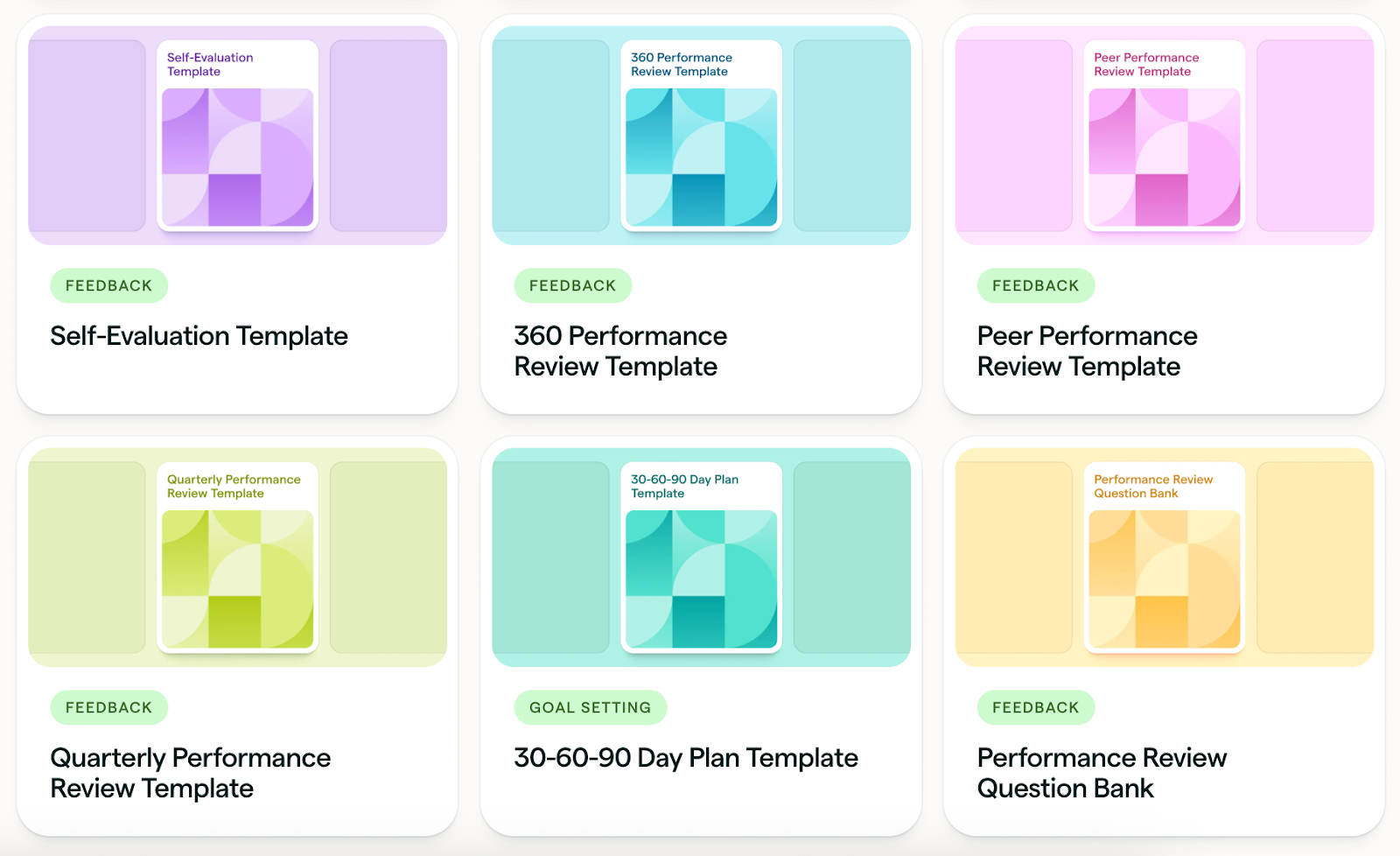Finding the right words can be a challenge, especially when it comes to performance reviews. Managers need to strike a delicate balance between acknowledging their team members’ successes and providing constructive feedback on areas for improvement.
To help achieve that balance, we’ve created an evergreen library of over 100 example phrases, tailored to key evaluation themes. Use them as a starting point for delivering feedback that’s specific, meaningful, and designed to encourage employee growth.
{{rich-takeaway}}
Why Performance Review Phrasing Matters
Words matter. Vague or overly generic feedback can confuse employees, leaving them uncertain about what they did well or what they need to improve. In contrast, precise, well-structured feedback helps employees understand expectations, take actionable steps, and stay engaged in their development.
The Risks of Poorly Structured Feedback
Managers who rely on vague statements, purely negative feedback, or generic examples can unintentionally create confusion or disengagement. Here’s how.
- Vague praise: “You did a great job this quarter.” → This doesn’t specify what was done well or which behaviors should be repeated.
- Overly harsh criticism: “You need to improve your leadership skills.” → This lacks specific guidance on what improvement looks like.
- Generic wording: “You’re a team player.” → This doesn’t meaningfully describe how they contribute to team success.
How Performance Review Phrasing Improves Engagement and Growth
Precise, behavior-focused performance review phrasing doesn’t just help evaluate past work; it also supports engagement, clarity, and professional growth.
- Clarifies expectations: “Your client presentations consistently include clear visuals, but you could add a section for next steps.” → This lets employees know what’s working, and what to refine.
- Promotes fairness and consistency: “You met three out of four of your quarterly sales targets, on track with the team average.” → This uses measurable language to ensure reviews are objective, not personality-driven.
- Supports career growth: “You led a cross-functional project which met all its goals. You could consider mentoring junior team members next year.” → This feedback clearly connects current performance to development opportunities.
Positive and Constructive Performance Review Phrases by Skill Area
Meaningful feedback goes beyond general observations. It employs clear, well-structured language to highlight achievements while also identifying growth opportunities. Use these example phrases as a starting point for delivering feedback that’s personalized, meaningful, actionable, and aligned with business goals.
Communication Skills
Strong communication skills are essential for success in any role. Whether an employee is collaborating with team members, managing client relationships, or presenting information, their ability to communicate effectively impacts team efficiency, alignment, and overall workplace productivity.
Teamwork and Collaboration
Teamwork and interpersonal skills are essential for high performance and employee engagement. Good team relationships not only increase job satisfaction and psychological safety for the individual, but they also help the whole team perform better, supporting greater knowledge sharing and innovation.
Goal Achievement
Evaluating how well employees have set and met their goals is a core part of the performance management and review process. “I like to use phrases that home in on key positive traits of the employee that are benefiting our business, then back them up with specific examples,” said Ravi Parikh, CEO of RoverPass. Parikh offered this phrasing as an example: “Your implementation of chatbots on our websites contributed to a 21% rise in online sales this past year.”
Creativity, Problem-Solving, and Critical Thinking
Evaluating these skills means considering how employees generate ideas, approach new challenges, and use their problem-solving ability to complete tasks.
“[It’s important to] acknowledge an individual who develops creative strategies and seeks creative solutions to challenging obstacles,” said Lori B. Rassas, SPHR-certified employment attorney and author of It’s About You Too: How to Manage Employee Resistance to Your Diversity Initiatives and Improve Workplace Culture and Profitability. “You want to be sure to acknowledge those who carefully evaluated the pros and cons of challenging decisions and excelled in seeking solutions.”
{{rich-highlight-2}}
Flexibility and Adaptability
During times of change — like a merger or acquisition, layoff, or economic instability — adaptability is vital for keeping your team motivated, engaged, and performing at their best. It’s what helps your people adjust quickly to a new work environment, maintain their work ethic during trying times, or proactively learn new skills to help them overcome challenges.
Time Management and Dependability
These skills are key components of a well-oiled, productive team. When evaluating time management and dependability in performance reviews, it’s important to consider how each team member manages their time in individual tasks, plus how this impacts the wider team’s goal accomplishment and employee engagement.
Leadership and Management
When evaluating leadership and management skills, don’t just consider how well your leaders lead. Employees in leadership and management positions also need to make strategic decisions, coach and mentor their colleagues, and foster a positive team culture.
Attention to Detail and Accuracy
Employees who demonstrate strong attention to detail ensure that their work is precise, thorough, and error-free. This skill is essential for all roles, but especially those that require data accuracy, compliance with processes, or high levels of quality control.
{{rich-highlight-4}}
Things to Avoid When Writing Employee Performance Reviews
Getting the words right in a performance review means your employees have clear, specific information on what they’ve done well, what they need to improve, and critically, how they can get there. But beyond saying the right things, there are a few key rules of thumb for what to avoid in a performance review.
1. Don’t be vague.
Ambiguous wording often slips into written and verbal communication. Phrases like “great job” or “needs improvement” don’t tell employees what they did well or what to do differently next time.
For greater clarity during performance reviews, avoid business jargon, acronyms, or team-specific cultural references that might confuse people. Instead, opt for simple sentences and specific details that clearly point to the next steps.
Tip: Pair written examples with a short, verbal explanation, and always ask if any clarification is needed.
2. Avoid absolutes.
It’s rare that an employee always or never does something, so avoid absolutes. If an employee is often late to work, avoid saying, “You’re always late” or “You’re never punctual.” Rebecca Southern Mills, HR consultant and founder of Simplecated, said managers should provide more accurate and specific feedback, like, “You’ve been late to work at least twice a week for the last six months.”
Tip: Use measurable, time-bound language, for example: “Missed two of five quarterly deadlines. All other deadlines were met on time.”
3. Skip surprises.
“Nothing in a performance review should ever come as a surprise to a team member,” said Arron Grow, CEO at management consulting firm AP Grow and Associates and author of How to Not Suck as a Manager.
Great managers use open communication and regular feedback to ensure every member of their team knows how they’re performing. “If something needs to be said to help a team member improve, have that conversation (or two) long before the performance review,” Grow advised. “Surprises are great for holidays and birthdays, but not for performance reviews.”
Tip: Use an HR tool like Lattice to document key feedback throughout the year and reference prior discussions during performance appraisals.
{{rich-highlight-1}}
4. Avoid personality-based language.
Personality-based language like “too emotional” or “very outspoken” is subjective. Instead, focus on observable actions and outcomes, not assumptions about personality or intent.
Tip: Replace personality-based language with specific behavior and observable outcomes. For example, if a team member interrupts or speaks over others, note this and suggest ways for them to improve, rather than saying they’re too outspoken.
5. Don’t use the feedback sandwich method.
The feedback sandwich, delivering criticism between two positive comments, has long been a popular technique for performance reviews. But negativity bias means most people naturally remember negative feedback more vividly, which means positive comments may be overshadowed.
Tip: Separate positive and negative feedback in a clear, structured manner. Always pair criticism with context and actionable suggestions, so employees know how to improve.
6. Don’t compare employees by name.
Named comparisons between direct reports don’t just have potential consequences for employee confidentiality; they can also create tension within teams. Employees should never be compared against others in their team, but should always be assessed against objective metrics.
Tip: Use key performance indicators (KPIs), project outcomes, or SMART goals to measure each employee’s individual performance and progress.
7. Avoid mentioning issues from more than six months ago.
Bringing up old issues can overshadow more recent achievements. If performance reviews are based on an annual cadence, try to focus on examples from the last three to six months, and consider how they’re relevant to current goals and development opportunities.
Tip: Keep a running record of feedback throughout the year, so you can pull out timely, relevant examples during performance review season. Lattice Feedback allows managers to store feedback about each team member.
Knowing what not to say is one thing, but knowing how to reframe it is another. Use these examples of what not to say, plus how to reframe your feedback to guide performance improvement and growth.
Be mindful of timing and delivery.
Effective performance reviews are about more than just what you say. The timing and delivery of feedback also affect how it’s received, especially in sensitive or constructive conversations.
Building a fairer, more effective review process includes following best practices like these:
- Never give feedback when you’re frustrated. Take a 24-hour pause, even if that means rescheduling a review. If you do need to reschedule, make sure to send a message clearly taking ownership of the reason.
- Don’t deliver serious or developmental feedback via email or Slack. This should always be saved for a face-to-face meeting.
- Address issues incrementally. Rather than saving multiple issues for one big conversation, aim for frequent, timely feedback.
Performance Review Examples of Coded Terms and Better Alternatives
At first, coded terms or biased phrases, like “emotional,” “aggressive,” or “lacks initiative,” may seem neutral. But they often reinforce uneven expectations, particularly for women and underrepresented groups.
One way to avoid these terms is to focus on observable behaviors and measurable results, shifting from personality-based feedback to impact-based phrasing, like the examples in the table below:
Thoughtful, impact-based phrasing shapes how employees perceive the fairness and clarity of their reviews. When employees receive feedback that’s actionable instead of subjective, they’re more likely to trust the process, understand expectations, and feel supported by their manager.
Performance reviews are just one piece of performance management.
Reviews are a huge element of employee performance management, but they’re not the whole picture. Even if you write a motivational, accurate review, doing so in a vacuum without any other feedback won’t impact performance as much as you might hope.
To be truly effective, performance reviews need to exist within a wider ecosystem of performance management, including:
- Mid-year reviews
- Annual reviews
- Regular one-on-ones
- Everyday praise
- A consistent feedback culture
Managers also need to combine the specificity and clarity of their feedback with compassion, sensitivity, and empathy, so their teams feel recognized for their success, understand growth opportunities, and know what they need to do to perform their best.
{{rich-highlight-5}}
FAQs
What’s the difference between a performance review and feedback given during one-on-ones?
Performance reviews and one-on-ones both rely on constructive criticism and feedback, but there are differences in the tone and focus of these conversations. One-on-ones are typically informal, weekly or biweekly conversations that focus on continuous performance feedback and short-term goals. Performance reviews are more structured, formal, and in-depth, and are usually held quarterly, biannually, or annually. They focus on long-term objectives and ongoing performance development.
How do performance review phrases vary for self-evaluations vs. manager evaluations?
Self-evaluations typically ask employees to reflect on and rate their own performance, highlighting strengths, challenges, and growth areas. In contrast, manager-employee evaluations focus on assessing performance toward defined metrics or goals, providing evidence-based feedback that helps guide future performance.
Can using the wrong phrase create legal or HR risks?
Potentially, yes. Using subjective opinions, coded terms, or stereotypes can create legal or HR risks, in addition to fueling discrimination and wrongful termination claims.
How do you make performance review phrases less biased?
To avoid writing biased reviews, managers should always focus on evidence-based, specific examples, plus avoid coded or biased phrases. Lattice AI can help managers write better reviews by checking for bias and offering suggestions for objective language.

Free Performance Review Template
Performance reviews can leave you feeling tongue-tied. Our performance review conversation template gives you a framework to turn a potentially awkward exchange into a profoundly meaningful one.

11 Free Performance Review Templates
The performance review season can be time-consuming and complex — but it doesn’t have to be. Use these 11 free performance review templates to streamline your existing process, without compromising the quality of your feedback.
How Lattice Helps Managers Write Better Reviews

Using a structured performance management system like Lattice Reviews can help reduce the overwhelm of getting reviews right and improve their quality over time by:
- Reducing bias: Calibration sessions and 360-degree feedback help managers spot — and resolve — patterns and inconsistencies before reviews are finalized, creating a more equitable appraisal process.
- Uncovering context: Lattice pulls relevant goals, past feedback, and one-on-one notes so managers can write reviews grounded in year-round conversations, not just recent memories.
- Streamlining workflows: HR teams can track completion rates, ensure reviewer alignment, and identify coaching opportunities across the organization.
Consolidating all this advice into written reviews might seem like a tall order. But Lattice is here to help. If you’re a new manager, download our free workbook, Preparing for Performance Reviews as a First-Time Manager. And if you’re an HR leader looking to enable your managers, book a Lattice demo to see our continuous feedback features in action.
✨Key Takeaways
- Poorly structured, vague feedback can create confusion and disengagement. Precise, focused feedback helps employees understand what they’ve done right, while also supporting engagement and growth.
- Managers can improve the quality of both positive and constructive feedback by using clear language and specific examples.
- It’s important to avoid common mistakes, including giving vague feedback, making personality-based comments, and using coded terms or biased phrases.
- Lattice can help managers write better reviews by streamlining workflows and surfacing context like relevant goals and 360 feedback.









